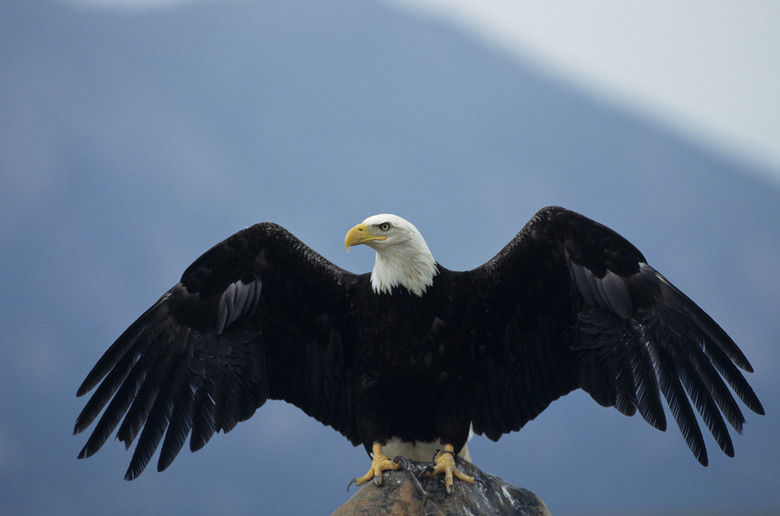How Wings Are An Adaptation For Birds
Over millions of years, birds have perfected the body structure needed for flight. In fact, a bird's entire being has adapted to a life of soaring through the air. Besides insects and bats, no other group of animals can truly fly. Bird wings are uniquely adapted to their way of life, from the daily search for food to yearly migrations lasting thousands of miles. Birds inherited wing structures from their ancestors that allow them to escape from predators, take advantage of more food sources and make life less stressful.
From Dinosaurs to Birds
From Dinosaurs to Birds
Birds are now widely accepted as having descended from a form of dinosaurs, evolving from a line of meat-eating dinosaurs called maniraptoran theropods similar to the velociraptor. According to their fossil record, these dinosaurs evolved features such as wishbones and thin-shelled eggs that resemble those of modern birds.
The first bird was possibly Archaeopteryx, a winged creature that may have been capable of true flight. Some of the first birdlike creatures sported feathers on their legs, as well as their arms. Studies suggest that ancient birdlike animals actually used two sets of wings to fly.
Feathers and Wings
Feathers and Wings
Before birds could take to the sky, they had to evolve feathers adapted to the mechanics of flying, and even specific flight styles. Feathers are light but remarkably strong. Remiges are the flight, or wing, feathers. The primary remiges – large wing feathers – attach to the "hand" portion of the wing. The secondary remiges attach to the forearm and help provide lift when the bird is soaring or flapping.
Besides the feathers themselves, the shape of the wings figure into a bird's flying ability. Short, rounded wings help birds take off rapidly. Long, pointed wings provide speed. Long, narrow wings allow for gliding. Broad wings with slots let birds both soar and glide.
Regulating Body Temperature
Regulating Body Temperature
Birds don't necessarily use their wings for flight only – wings also allow birds to regulate their body temperatures. Birds such as the Anhingas lose heat rapidly from their bodies, so by spreading their wings and turning their backs on the sun, they can absorb solar energy to heat themselves. Turkey Vultures also use these spread-wing postures to raise their temperatures from lower nighttime to higher daytime levels.
Adapted to Soaring
Adapted to Soaring
Birds don't have to flap their wings all the time to stay airborne – they can conserve their energy by soaring. The force of rising columns of air called updrafts and thermals keep birds aloft. Some birds, namely seabirds such as albatrosses, spend much of their time in the air soaring. Seabirds use the updrafts created by the actions of waves to soar.
Soaring birds tend to have high-aspect-ratio wings, meaning their wing lengths are much greater than their wing areas. This quality gives soaring birds their characteristic long, thin wings.
Flightless Birds
Flightless Birds
Although flightless birds have adapted to life below, their wings have not entirely disappeared from their anatomies. Birds evolved to fly, but some birds have lost this ability when their bodies eventually adapted to terrestrial or aquatic environments and flying became too costly, energy-wise.
Penguin wings have basically changed into flippers to facilitate swimming. The Flightless Cormorant of the Galapagos Islands used to be able to fly, but has since lost that capacity in favor of gliding through the water. Large birds, such as ostriches and rheas, use their proportionately smaller wings in impressive displays.
Migratory Birds
Migratory Birds
Many birds take long flights called migrations to warmer regions of the world during the colder months. The Arctic Tern's migration path covers a round trip of more than 30,000 kilometers from the Arctic to the Antarctic. The Blackpoll Warbler makes its annual trip by staying in the air for 80 to 90 hours without resting.
Not all birds possess the ability to migrate, however: In addition to internal bird adaptations, specialized wings aid migratory birds in making their long flights. Migrating birds feature more pointed wings, which are large compared to their bodies, resulting in less laborious flying.
Ongoing Evolution
Ongoing Evolution
Evolution hasn't quite finished its job with the bird wing. Evidence of evolution00194-2) has been found occurring in the wings of cliff swallows in Nebraska. Road killed cliff swallows have been found to have longer wings than many others in their populations. It is possible that these swallows, nesting in highway bridges and overpasses, evolved shorter, rounder wings to be able to take off in a more vertical fashion, thereby allowing the birds to flee from oncoming vehicles.
References
- Scientific American: First Birds Might Have Flown on Four Wings
- The Cornell Lab Bird Academy: Everything You Need to Know About Feathers
- Stanford University: Soaring
- PLOS One: Pointed Wings, Low Wing Loading and Calm Air Reduce Migratory Flight Costs in Songbirds
- Current Biology: Where Has All the Road Kill Gone?
Cite This Article
MLA
Dinh, Ho-Diep. "How Wings Are An Adaptation For Birds" sciencing.com, https://www.sciencing.com/wings-adaptation-birds-23773/. 30 September 2021.
APA
Dinh, Ho-Diep. (2021, September 30). How Wings Are An Adaptation For Birds. sciencing.com. Retrieved from https://www.sciencing.com/wings-adaptation-birds-23773/
Chicago
Dinh, Ho-Diep. How Wings Are An Adaptation For Birds last modified March 24, 2022. https://www.sciencing.com/wings-adaptation-birds-23773/
